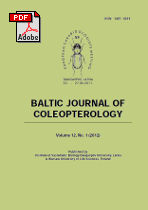Variation in epigeic carabid fauna (Coleoptera: Carabidae) on differently-ferently-treated post-agricultural land
Main Article Content
Keywords
:
Carabidae, fallow ground, forest, succession, MIB, landscape
Abstract
The treatment of post-agricultural areas may influence ecological processes such as succession, and thus influence species occurrence. We studied carabid coenoses on differently treated post-agricultural land. Carabids were collected using pitfall traps on five study sites during 2004-2010: a planted pine forest (26 years old in 2004), a naturally-regenerated pine stand (about 5 years old in 2004), two irregularly-mown sites without biomass removal, and a regularly-mown site with biomass removal. The number of species, number of individuals, total biomass and Mean Individual Biomass (MIB) were analysed to compare the successional processes among the five study sites. Unconstrained ordination (CA) was run to obtain information about the environmental basis in determining the structure of the carabid coenoses based on the variation pattern. Altogether 5539 individuals from 77 species were collected. Five species, Harpalus rubripes, Calathus fuscipes, Calathus erratus, Pterostichus niger and Calathus melanocephalus, made up > 50% of all specimens. Numbers of species and individuals were highest on the regularly-mown site and lowest in the forest. These parameters showed decreasing trends on all sites, but were significant only for the species number on the planted pine stand. Total biomass decreased in almost all cases, with particularly low values for the irregularly-mown sites. MIB was low for the managed sites, but high in the planted pine forest. MIB increased significantly on the naturally-regenerated pine forest during the study years. CA indicated that the stage of succession was the most important factor in determining the carabid coenoses. The method of treatment of post-agricultural land significantly influences the successional stage and species composition of carabids. Therefore, a well-thought-out management of post-agricultural areas within a landscape may be an important instrument to protect biological diversity.
Article Details
Statistics
Downloads
Download data is not yet available.
Recommend Articles
